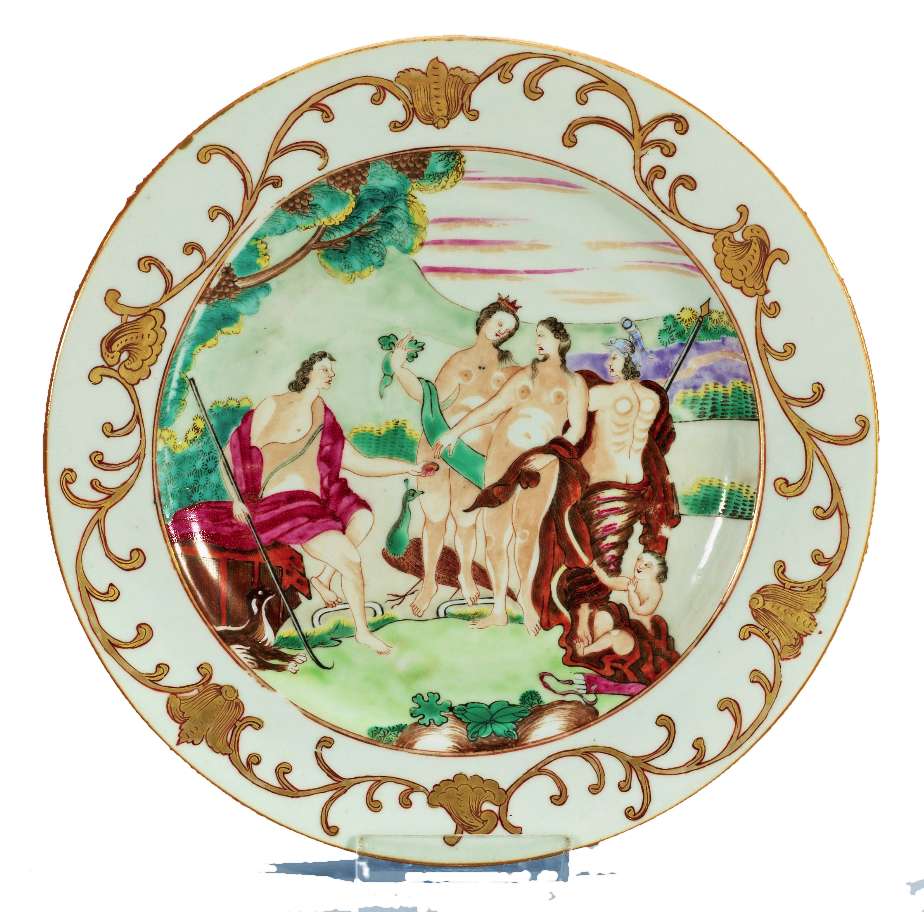
Mid 18th century Chinese export porcelain plate decorated with a rendering of 'The Judgment of Paris'. Qianlong period, mid 18th century, ca 1750. In this version only Paris and Hermes appears together with the two goddesses Hera and Athena while Aphrodite seems to have been replaced with Eros (Roman: Cupid), the God of Love (bottom right).
The Judgment of Paris is a story from Greek mythology, which was one of the events that led up to the Trojan War and (in slightly later versions of the story) to the foundation of Rome. The scene traditionally referred to as The Judgment of Paris illustrates the moment when Hermes (Mercury) (right) bringing to Paris - the mortal son of King Priam of Troy (left) the goddesses Hera (Roman: Juno), Athena (Roman: Minerva) and Aphrodite (Roman: Venus) of whose beauty he is to judge.
Anyone can figure out that this is not going to work out well.
The plate shows the final stage where Paris is awarding the golden apple to Venus, standing between Hera with her peacock (left) and Hermes (right).
No exactly matching source for this motif has ever been found however it is usually attributed to Peter Paul Rubens (1577-1640). The Judgment of Paris probably 1632-35. On the whole the Rubens version is very matching if we accept that the artist has swung around the group 180 degrees so that the ladies could be observed from the front. The little Eros, the shepherds staff however turned upside down, dog, Hermes wings however turned into a helmet, peacock and drapes etc. are all there.
The subject matter occurs in innumerable paintings and remained popular with classical painters for many years during due to its popular appeal. In the various paintings that could have served as sources to the Chinese export porcelain versions attributes like spears, Paris' seat, the crown, cloths and the helmet as well as the seated Eros with his arrows at the goddesses feet differs or are missing.
Many different versions of this Chinese Porcelain pattern occur, using different color schemes, arrangements of the scene, as well as numerous border styles, including one with views of Plymouth. The central scene does not vary much, unlike the border designs. It is therefore likely there were several different Chinese export porcelain services produced over a number of years reinterpreting this design, the period of production ranged from the mid 1740`s to possibly as late as the 1760`s.
Popular dramatizations of this story during the 18th century includes an opera, The Judgment of Paris, with a libretto by William Congreve, that was set to music by four composers in London, 1700-1701. Thomas Arne composed a highly successful score to the same libretto in 1742. The opera Le Cinesi (The Chinese Women) by Christoph Willibald Gluck in one act, concludes with a ballet, The Judgment of Paris, sung as a vocal quartet. The work which is reasonable well known was first performed for the Austrian royal family at the Vienna Schlosshof on September 24, 1754, on the occasion of the visit of the Empress Maria Theresa to the household of Saxe-Hildburghausen. If something, this opera is contemporary with the period of this plate.
Hera (Greek), same as Juno (Roman). Zeus's wife and sister. Protector of marriage, spent most of her time punishing the many women Zeus fell in love with. Attributes are cows and peacocks.
Athena (Greek), same as Minerva (Roman). Daughter of Zeus,sprang from his head full-grown and in full armor. The protector of civilized life, handicrafts, and agriculture. Invented the bridle, and first to tame the horse. Attributes: Athens, olives, and owls.
Aphrodite (Greek), same as Venus (Roman). Daughter of Zeus. Goddess of Love and Beauty. Attributes: the myrtle tree, doves, sparrows, and swans.
A